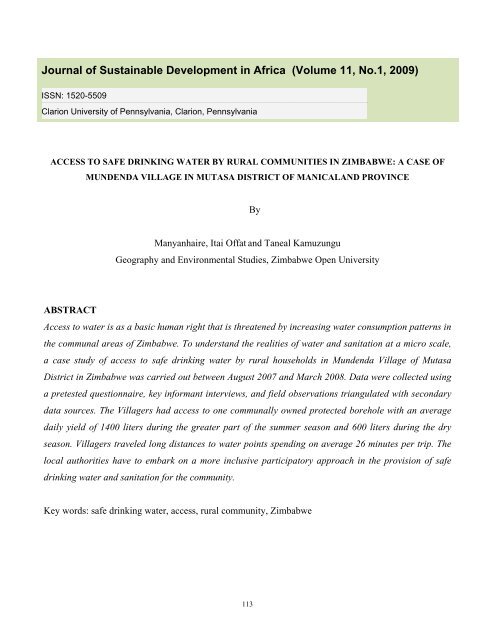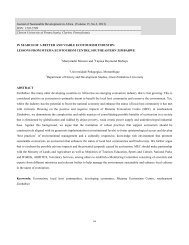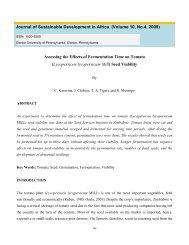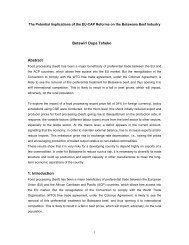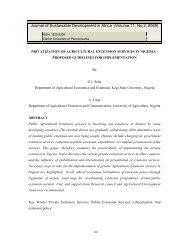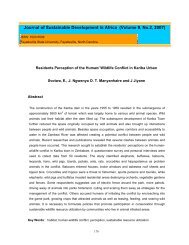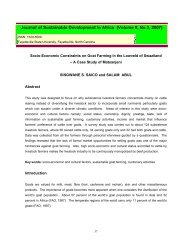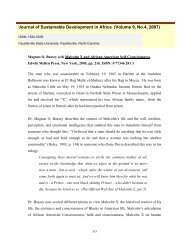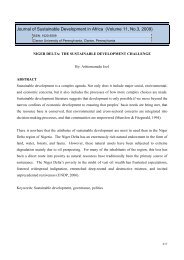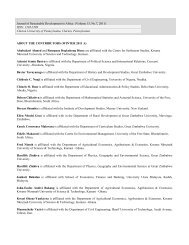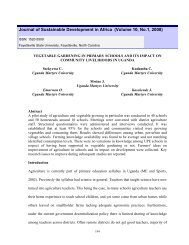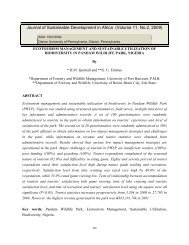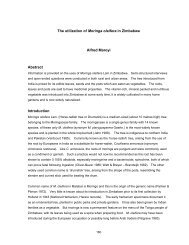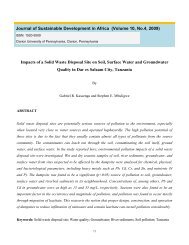Access to Safe Drinking Water by Rural Communities in Zimbabwe
Access to Safe Drinking Water by Rural Communities in Zimbabwe
Access to Safe Drinking Water by Rural Communities in Zimbabwe
You also want an ePaper? Increase the reach of your titles
YUMPU automatically turns print PDFs into web optimized ePapers that Google loves.
Journal of Susta<strong>in</strong>able Development <strong>in</strong> Africa (Volume 11, No.1, 2009)<br />
ISSN: 1520-5509<br />
Clarion University of Pennsylvania, Clarion, Pennsylvania<br />
ACCESS TO SAFE DRINKING WATER BY RURAL COMMUNITIES IN ZIMBABWE: A CASE OF<br />
MUNDENDA VILLAGE IN MUTASA DISTRICT OF MANICALAND PROVINCE<br />
By<br />
Manyanhaire, Itai Offat and Taneal Kamuzungu<br />
Geography and Environmental Studies, <strong>Zimbabwe</strong> Open University<br />
ABSTRACT<br />
<strong>Access</strong> <strong>to</strong> water is as a basic human right that is threatened <strong>by</strong> <strong>in</strong>creas<strong>in</strong>g water consumption patterns <strong>in</strong><br />
the communal areas of <strong>Zimbabwe</strong>. To understand the realities of water and sanitation at a micro scale,<br />
a case study of access <strong>to</strong> safe dr<strong>in</strong>k<strong>in</strong>g water <strong>by</strong> rural households <strong>in</strong> Mundenda Village of Mutasa<br />
District <strong>in</strong> <strong>Zimbabwe</strong> was carried out between August 2007 and March 2008. Data were collected us<strong>in</strong>g<br />
a pretested questionnaire, key <strong>in</strong>formant <strong>in</strong>terviews, and field observations triangulated with secondary<br />
data sources. The Villagers had access <strong>to</strong> one communally owned protected borehole with an average<br />
daily yield of 1400 liters dur<strong>in</strong>g the greater part of the summer season and 600 liters dur<strong>in</strong>g the dry<br />
season. Villagers traveled long distances <strong>to</strong> water po<strong>in</strong>ts spend<strong>in</strong>g on average 26 m<strong>in</strong>utes per trip. The<br />
local authorities have <strong>to</strong> embark on a more <strong>in</strong>clusive participa<strong>to</strong>ry approach <strong>in</strong> the provision of safe<br />
dr<strong>in</strong>k<strong>in</strong>g water and sanitation for the community.<br />
Key words: safe dr<strong>in</strong>k<strong>in</strong>g water, access, rural community, <strong>Zimbabwe</strong><br />
113
INTRODUCTION<br />
The world faces severe and grow<strong>in</strong>g challenges <strong>to</strong> susta<strong>in</strong> water quality and <strong>to</strong> meet the rapidly grow<strong>in</strong>g<br />
demand for water resources, particularly among rural communities <strong>in</strong> Africa and <strong>Zimbabwe</strong>. This is<br />
despite the efforts (through the Integrated <strong>Rural</strong> <strong>Water</strong> Supply and Sanitation Programme) <strong>by</strong> the<br />
<strong>Zimbabwe</strong> Government and the donor community <strong>to</strong> improve the availability of safe dr<strong>in</strong>k<strong>in</strong>g water <strong>to</strong><br />
rural communities as an important policy matter s<strong>in</strong>ce the 1980s. With <strong>in</strong>creas<strong>in</strong>g population water<br />
demand <strong>in</strong> Africa and <strong>Zimbabwe</strong> cont<strong>in</strong>ue <strong>to</strong> rise and present challenges <strong>to</strong> the supply of water <strong>to</strong> rural<br />
communities. Critical determ<strong>in</strong>ants <strong>to</strong> this scenario <strong>in</strong>clude distance <strong>to</strong> the water po<strong>in</strong>t, polluted water<br />
sources, perennial droughts, depleted ground water sources, and poorly formulated water and sanitation<br />
policies. Given this scenario, it was imperative that a deeper understand<strong>in</strong>g of the dynamics of access <strong>to</strong><br />
water <strong>in</strong> the rural environment were explored with the view <strong>to</strong> <strong>in</strong>fluence policy. To achieve this, the<br />
paper exam<strong>in</strong>es the sources of water, access <strong>to</strong> water <strong>by</strong> households, constra<strong>in</strong>ts <strong>to</strong> the provision of safe<br />
dr<strong>in</strong>k<strong>in</strong>g water, and the related environmental health implications of unsafe dr<strong>in</strong>k<strong>in</strong>g water. Micro scale<br />
studies of this nature are critical <strong>in</strong> identify<strong>in</strong>g environmental health risks associated with the cont<strong>in</strong>ued<br />
limited access <strong>to</strong> safe dr<strong>in</strong>k<strong>in</strong>g water <strong>in</strong> the rural areas of <strong>Zimbabwe</strong>. This was done on the assumption<br />
that the rural water provision programme has not met the desired targets of safe and readily accessible<br />
water <strong>to</strong> rural households.<br />
LITERATURE REVIEW<br />
<strong>Access</strong> <strong>to</strong> <strong>Water</strong> and Consumption Patterns among <strong>Rural</strong> <strong>Communities</strong><br />
<strong>Access</strong> <strong>to</strong> water entails be<strong>in</strong>g with<strong>in</strong> safe physical reach, be<strong>in</strong>g affordable, accessible <strong>in</strong> law and <strong>in</strong> fact<br />
<strong>in</strong>formation on water issues be<strong>in</strong>g provided (UN, 2003). Reasonable access, thus, is the availability of at<br />
least 20 liters of water per person per day from a source with<strong>in</strong> one kilometer of the homestead (WHO,<br />
needs date). Improv<strong>in</strong>g access <strong>to</strong> water has been the thrust of most governments, UN agencies, and<br />
many different organizations but these have failed <strong>to</strong> satisfy demand <strong>in</strong> the shortest time. The water<br />
supply and sanitation coverage for Africa rema<strong>in</strong>s the lowest at 62% and 60% respectively<br />
(WHO/UNICEF/WSSCC, 2000). This contrasts the coverage <strong>in</strong> <strong>Zimbabwe</strong>, which has decl<strong>in</strong>ed <strong>to</strong> 30%<br />
<strong>in</strong> the last eight years ow<strong>in</strong>g <strong>to</strong> a host of fac<strong>to</strong>rs, <strong>in</strong>clud<strong>in</strong>g destruction of <strong>in</strong>frastructure <strong>by</strong> Cyclone<br />
El<strong>in</strong>e, frequent droughts, and f<strong>in</strong>ancial challenges. Thus, more than 75% of <strong>Zimbabwe</strong>'s population of<br />
12.5 million people cont<strong>in</strong>ues <strong>to</strong> live under water stressed conditions <strong>in</strong> most rural areas.<br />
114
<strong>Access</strong> <strong>to</strong> water is a basic human right that is threatened <strong>by</strong> <strong>in</strong>creas<strong>in</strong>g consumption patterns (Seckler,<br />
Molden, and Backer, 1998). <strong>Water</strong> scarcity means <strong>in</strong>sufficient quantity and quality; its supply <strong>in</strong><br />
communal areas is determ<strong>in</strong>ed <strong>by</strong> population size, frequent droughts, lack of f<strong>in</strong>ances and plann<strong>in</strong>g,<br />
geophysical reality, climate change, excessive use, and pollution. Global consumption is doubl<strong>in</strong>g every<br />
20 years and more than one billion people have limited access <strong>to</strong> fresh dr<strong>in</strong>k<strong>in</strong>g water (Bhatia, Gestti,<br />
and Wimpenny, 1996; Falkenmark and Widstrand, 1992). In Sub Saharan Africa, 51% of the people<br />
lacked access <strong>to</strong> safe supply of water and 41% lacked adequate sanitation, whilst 14 countries were<br />
already experienc<strong>in</strong>g water stress and another 11 countries were expected <strong>to</strong> jo<strong>in</strong> them <strong>by</strong> 2025 (Adams,<br />
1999). Malawi and South Africa were projected <strong>to</strong> have absolute water shortages (availability of 1,000<br />
m 3 of fresh water per year or less), while Lesotho and <strong>Zimbabwe</strong> will be stressed (1,000 m 3 – 17,000 m 3<br />
of fresh water per year); Angola, Botswana, Zambia, and Swaziland are likely <strong>to</strong> experience water<br />
quality and availability problems <strong>in</strong> the dry season (SADC/IUCN/SARDC, 2002; Tevera, 2004). Thus,<br />
the world faces daunt<strong>in</strong>g challenges <strong>to</strong>wards the provision of water and sanitation where countries like<br />
Mozambique less than half of the population has latr<strong>in</strong>es (S<strong>to</strong>ckholm <strong>Water</strong> Front, 2006). This requires<br />
more than the usual attention for sanity <strong>to</strong> prevail.<br />
It is estimated that 43% of rural Kenyans had either a household connection <strong>to</strong> water or had reasonable<br />
access <strong>to</strong> improved water sources <strong>in</strong> 2000 (WHO/UNICEF, 2003). Women pay the heaviest price for<br />
poor water supply and sanitation (WHO, 2000) as they are forced <strong>to</strong> walk long distances <strong>to</strong> fetch water.<br />
Small-scale water service providers, such as community-based organizations and <strong>in</strong>dependent private<br />
providers are be<strong>in</strong>g <strong>in</strong>creas<strong>in</strong>gly recognized as significant providers of water services <strong>in</strong> Africa.<br />
Collectively, they provide services <strong>to</strong> over 10% of urban and 30% of rural households <strong>in</strong> Kenya -<br />
account<strong>in</strong>g for over 30% of sec<strong>to</strong>r spend<strong>in</strong>g (Harvey and Reed, 2004). <strong>Access</strong> <strong>to</strong> f<strong>in</strong>ance and credit<br />
facilities is, however, severely restricted <strong>to</strong> such small-scale providers. As they have the potential <strong>to</strong><br />
save, borrow, and <strong>in</strong>vest for better services, sec<strong>to</strong>r policies should provide an enabl<strong>in</strong>g environment <strong>to</strong><br />
foster such <strong>in</strong>itiatives. Lack of funds, tra<strong>in</strong><strong>in</strong>g on the operation and ma<strong>in</strong>tenance of boreholes, dw<strong>in</strong>dl<strong>in</strong>g<br />
donor support for borehole projects and vandalism were some of the major challenges fac<strong>in</strong>g people <strong>in</strong><br />
rural areas (ibid).<br />
The amount of water that people need for a healthy life varies greatly between different peoples,<br />
between times of the year, days of the week, and particular circumstances. Nomadic people displaced <strong>in</strong><br />
115
Somaliland <strong>in</strong> 1992 had long stand<strong>in</strong>g water use habits based on just 2-3 liters per person per day,<br />
whereas Kurdish refugees <strong>in</strong> Northern Iraq had been used <strong>to</strong> at least 100 liters per person per day<br />
(Adams, 1999). Provid<strong>in</strong>g water for animals may also be essential for health. If it is not provided, people<br />
will consume less themselves or their animals will not thrive, mak<strong>in</strong>g their livelihoods suffer. If there’s<br />
<strong>in</strong>adequate provision for animals, there may be conflict over the use of water sources. Governments <strong>in</strong><br />
develop<strong>in</strong>g countries have often subsidized water supplies <strong>to</strong> achieve social and health benefits for the<br />
low-<strong>in</strong>come rural households.<br />
The lack of reliable and good quality water sources is one of the pr<strong>in</strong>cipal constra<strong>in</strong>ts <strong>to</strong> development.<br />
For example, <strong>in</strong> South East <strong>Zimbabwe</strong>, surveys showed that 32 percent of the people relied on relatively<br />
unsafe water from unprotected wells, rivers, streams, and dams and that 73 percent of people walked at<br />
least 500 meters <strong>to</strong> their nearest sources of water (ZEWSP, 2006). Due <strong>to</strong> the scarcity of water and<br />
<strong>in</strong>frastructure <strong>in</strong> many countries <strong>in</strong> the region of Africa, women (particularly those <strong>in</strong> rural areas) are<br />
forced <strong>to</strong> walk long distances <strong>to</strong> fetch water. The risk of contam<strong>in</strong>ation is present dur<strong>in</strong>g the transport of<br />
water from the source <strong>to</strong> the home and s<strong>to</strong>rage, but there is <strong>to</strong>o little data <strong>to</strong> relate this risk <strong>to</strong> service<br />
level or water supply <strong>in</strong>terventions. Increased supply may reduce the risk of contam<strong>in</strong>ation dur<strong>in</strong>g<br />
transportation and hand wash<strong>in</strong>g is less common when a water source is greater than one kilometre from<br />
the home, but more frequent when the water is more accessible.<br />
Time and energy spent collect<strong>in</strong>g water is also an important fac<strong>to</strong>r <strong>in</strong> provid<strong>in</strong>g more water for <strong>in</strong>creased<br />
hygiene practices; distance from the water source is a determ<strong>in</strong>ant for quality water supply. <strong>Water</strong><br />
needs <strong>to</strong> be available when required, and those who travel longer distances <strong>to</strong> the water po<strong>in</strong>t tend <strong>to</strong> use<br />
less and it negatively impacts consumption and hygiene practices. At least 40 liters of water should be<br />
available at less than 1.6 kilometers for every household and accessed with<strong>in</strong> a maximum 30 m<strong>in</strong>ute<br />
walk time carry<strong>in</strong>g three buckets one way (UNICEF, 1999). Collect<strong>in</strong>g water (an activity mostly<br />
conducted <strong>by</strong> women) requires them <strong>to</strong> walk <strong>to</strong> the source, wait <strong>in</strong> the queue, collect the water, and then<br />
carry it back. In <strong>Zimbabwe</strong>, the mean water collection trip with a heavy load on the head is estimated <strong>to</strong><br />
be 1.4 kilometers <strong>in</strong> the wet season and 2 kilometers <strong>in</strong> the dry season (National Master Plan). In<br />
drought years, it is possible for women <strong>in</strong> the more marg<strong>in</strong>al areas <strong>to</strong> travel up <strong>to</strong> 5 or 6 kilometers <strong>to</strong><br />
fetch water, amount<strong>in</strong>g <strong>to</strong> 40% of their daily untraditional <strong>in</strong>take travel<strong>in</strong>g <strong>to</strong> collect water (World Bank,<br />
1992). If the household has five members, it would require them <strong>to</strong> transport 200 liters of water daily.<br />
116
Manzvire village <strong>in</strong> Chip<strong>in</strong>ge District of <strong>Zimbabwe</strong> has a population of just over 5,500 with 514<br />
households. About 290 households have access <strong>to</strong> <strong>in</strong>dividual <strong>to</strong>ilets (Ventilated Improved Pit latr<strong>in</strong>es)<br />
and 180 have access <strong>to</strong> pit latr<strong>in</strong>es. At least 45 households were said <strong>to</strong> have zero access <strong>to</strong> any form of<br />
decent sanitation but were allowed temporary access <strong>to</strong> their neighbors’ facilities. There is no surface<br />
water <strong>in</strong> this village, with the closest source the Save River, approximately 15 kilometers away. People<br />
use boreholes and shallow wells as water supply sources. The village has 10 bore-holes, with at least<br />
eight reported <strong>to</strong> be functional. HIV/AIDS and rural/urban migration contribute <strong>to</strong> at least 80 percent of<br />
the households be<strong>in</strong>g female or orphan-headed (Katsi, 2006).<br />
In Domboshava, a rural area <strong>in</strong> <strong>Zimbabwe</strong>, water consumption per average household dur<strong>in</strong>g summer,<br />
w<strong>in</strong>ter, and autumn was estimated at 170 liters, 150 liters, and 124 liters per day, respectively (Morgan,<br />
1990; Morgan, 1992). When determ<strong>in</strong><strong>in</strong>g the value of clean water for domestic use, the location and<br />
convenience is a significant fac<strong>to</strong>r and is directly proportional <strong>to</strong> the distance traveled. For example,<br />
distances of several kilometers, the average consumption rate was 2-4 liters per day, up <strong>to</strong> a kilometer 4-<br />
8 liters per day, 10-20 liters for a water po<strong>in</strong>t next <strong>to</strong> the house, 60-100 liters for a home tap and 100-200<br />
liters for water <strong>in</strong> the kitchen and laundry (ibid). High consumption <strong>in</strong> the summer was due <strong>to</strong> the high<br />
temperatures and low consumption <strong>in</strong> the w<strong>in</strong>ter was attributed <strong>to</strong> the <strong>in</strong>crease <strong>in</strong> the cost of water.<br />
<strong>Water</strong> consumption rates per household were lower <strong>in</strong> Gwanda (97.5 L), Beitbridge (105 L), and<br />
Mangwe (84 L) Districts <strong>in</strong> the southern dry Districts of <strong>Zimbabwe</strong> (ZEWSP, 2006). People adapted<br />
their water requirements <strong>to</strong> the supply and under conditions of shortage, much lower quality water may<br />
be used for personal hygiene and for wash<strong>in</strong>g clothes.<br />
Environmental Health Risks Related with Sources of <strong>Dr<strong>in</strong>k<strong>in</strong>g</strong> <strong>Water</strong><br />
Accord<strong>in</strong>g <strong>to</strong> the World Health Organization (2000), “In its broadest sense, environmental health<br />
comprises those aspects of human health, disease, and <strong>in</strong>jury that are determ<strong>in</strong>ed or <strong>in</strong>fluenced <strong>by</strong><br />
fac<strong>to</strong>rs <strong>in</strong> the environment’’. This <strong>in</strong>cludes the study of both the direct pathological effects of various<br />
chemical, physical, and biological agents, as well as the effects on health of the broad physical and<br />
social environment, as the control of those fac<strong>to</strong>rs <strong>in</strong> the physical environment that have or may have a<br />
deleterious effect on man’s survival and well-be<strong>in</strong>g. It also def<strong>in</strong>es health as a state of complete<br />
physical, mental, and social well be<strong>in</strong>g, not merely the absence of disease or <strong>in</strong>firmity. Contam<strong>in</strong>ated<br />
water kills almost two million people per year and, accord<strong>in</strong>g <strong>to</strong> a 2005 United Nations Children's Fund<br />
117
eport, more than 4,000 children die every day because they do not have access <strong>to</strong> adequate supplies of<br />
clean water (UNICEF, 2005).<br />
Inadequate water supply and sanitation are largely responsible for the high levels of water borne<br />
diseases <strong>in</strong> Southern Africa, where the majority of people live <strong>in</strong> rural areas and do not have appropriate<br />
sanitation systems (Hirji, 2001; Hirji, 2002). Not surpris<strong>in</strong>gly, <strong>in</strong>fectious water borne diseases, such as<br />
dysentery, cholera, and hepatitis are almost endemic <strong>in</strong> places where water is scarce. Provid<strong>in</strong>g dr<strong>in</strong>k<strong>in</strong>g<br />
water free of disease-caus<strong>in</strong>g agents (whether biological or chemical) is the primary goal of all water<br />
supply systems (Faggle and Rabie, 1992). Accord<strong>in</strong>g <strong>to</strong> the UN, 3.3 billion illnesses and 5.3 million<br />
deaths were caused annually <strong>by</strong> unsafe water on a global scale (UN, 1999; WHO, 2000). In terms of<br />
morbidity and mortality rates l<strong>in</strong>ked <strong>to</strong> water quality, this is certa<strong>in</strong>ly true and the number of <strong>in</strong>fant<br />
deaths attributed <strong>to</strong> diarrhea transmitted <strong>by</strong> contam<strong>in</strong>ated dr<strong>in</strong>k<strong>in</strong>g water is a conv<strong>in</strong>c<strong>in</strong>g argument. It is<br />
the rural populations, which are suffer<strong>in</strong>g the most from such contam<strong>in</strong>ation of dr<strong>in</strong>k<strong>in</strong>g water. The<br />
numbers are and <strong>in</strong>creas<strong>in</strong>g at a rate, which makes it extremely difficult for water supply programs <strong>to</strong><br />
achieve significant improvements over and above demographic developments.<br />
Improv<strong>in</strong>g a water source may consist of fenc<strong>in</strong>g off a water source, construct<strong>in</strong>g a distribution system,<br />
and treat<strong>in</strong>g the water before it is consumed. <strong>Water</strong>borne pathogens can be blocked from enter<strong>in</strong>g a<br />
water supply and diseases can be largely barred from reach<strong>in</strong>g the population (Elimndorf and Buckles,<br />
1980). For example, consum<strong>in</strong>g a bacterium called Salmonella typhi, which is found <strong>in</strong> human feces,<br />
causes typhoid. A treatment program can be <strong>in</strong>itiated <strong>to</strong> remove the bacteria from the water before it can<br />
be consumed, protect<strong>in</strong>g the users (WHO, 2006; Miller, 1996). Typical methods normally advised for<br />
<strong>in</strong>activat<strong>in</strong>g microbes for rural water treatment at such levels are dis<strong>in</strong>fection treatments (with the use of<br />
hypo chlorite) and boil<strong>in</strong>g (with the use of heat) that have some efficiency on microbial content<br />
reduction. Although improved availability of water <strong>in</strong>creases health benefits, an <strong>in</strong>crease <strong>in</strong> the quantity<br />
of water used is not the only reason for health <strong>to</strong> improve. Effective use of water and the tim<strong>in</strong>g of<br />
hygiene practices can also hold important roles. In most cases, particularly where a large population is<br />
<strong>in</strong>volved, there is very little choice of water source. For large populations, at least <strong>in</strong> the short term, what<br />
is usually needed is a source of surface water that can be treated <strong>by</strong> us<strong>in</strong>g techniques and equipment that<br />
are tried, tested, and available <strong>to</strong> produce sufficient water of adequate quality (Adams, 1999).<br />
118
As with most African countries, gett<strong>in</strong>g clean, safe water everyday poses a major headache for many<br />
rural households <strong>in</strong> <strong>Zimbabwe</strong>. The unavailability of safe and clean water has exposed people <strong>to</strong> many<br />
waterborne diseases. This has been exacerbated <strong>by</strong> breakage of borehole stands and pulley ropes,<br />
damaged pis<strong>to</strong>ns, poor ma<strong>in</strong>tenance of water sources <strong>to</strong> prevent build-up of dirt, algae and weeds which<br />
clog the pump and pipes dur<strong>in</strong>g suction, and breakdowns ow<strong>in</strong>g <strong>to</strong> suction of mud. Thus, the challenge<br />
of access <strong>to</strong> safe dr<strong>in</strong>k<strong>in</strong>g water <strong>in</strong> communal areas is still largely a pipe dream and faces challenges <strong>in</strong><br />
the wake of achiev<strong>in</strong>g the Millennium Development Goals <strong>by</strong> 2015.<br />
STUDY AREA<br />
Mundenda Village is located <strong>in</strong> Mutasa District approximately 51 kilometers north of the city of Mutare.<br />
The area is generally high above 1,000 meters cover<strong>in</strong>g the western ends of the Eastern Highlands. It is<br />
characterized <strong>by</strong> a multitude of undulat<strong>in</strong>g slopes and with a granitic basement. Soil depths depict great<br />
variations. The high po<strong>in</strong>ts are shallow and achiev<strong>in</strong>g greater <strong>to</strong>wards the valleys. The area is <strong>in</strong> natural<br />
farm<strong>in</strong>g region two with an average ra<strong>in</strong>fall of above 600 millimeters per year.<br />
Method and Material<br />
This was a descriptive survey on access <strong>to</strong> safe dr<strong>in</strong>k<strong>in</strong>g water <strong>by</strong> rural households <strong>in</strong> Mundenda Village<br />
<strong>in</strong> Mutasa District. Data was collected us<strong>in</strong>g a pretested questionnaire distributed <strong>to</strong> 50 randomly<br />
selected households from a population of 70 households (71% of the population), key <strong>in</strong>formant<br />
<strong>in</strong>terviews with traditional leaders, and field observations triangulated with secondary data sources. The<br />
questionnaire provided standardization and uniformity <strong>in</strong> data collected on the aspects of access <strong>to</strong> water<br />
and the constra<strong>in</strong>ts that were encountered <strong>in</strong> provid<strong>in</strong>g safe dr<strong>in</strong>k<strong>in</strong>g water for the village. To guarantee<br />
high rate of return and <strong>to</strong> overcome the issue of illiteracy, personal <strong>in</strong>terviews were conducted with the<br />
targeted heads of households. To complement this, key <strong>in</strong>formant <strong>in</strong>terviews were conducted with the<br />
village head, the environmental health technician, and a representative of the non-governmental<br />
organization that was active <strong>in</strong> water supply and sanitation <strong>in</strong> the area dur<strong>in</strong>g the time of study. The<br />
accuracy of data collected was validated through field observations on available water sources, the<br />
conditions of the water sources, and the trips that women made <strong>to</strong> the wells. Effective field observations<br />
were achieved through the use of a prepared observation guide. This was done between September 2007<br />
and April 2008.<br />
119
The generated data was coded and synthesized <strong>to</strong> facilitate process<strong>in</strong>g, check<strong>in</strong>g and cross referenc<strong>in</strong>g<br />
the data, rank<strong>in</strong>g of responses, and calculat<strong>in</strong>g proportions expressed as percentages. The data was thus<br />
organized and split <strong>in</strong><strong>to</strong> units search<strong>in</strong>g for patterns and discover<strong>in</strong>g the l<strong>in</strong>kages between concepts, data,<br />
and responses from various respondents. Moreover, s<strong>in</strong>ce the approach <strong>in</strong> this project was qualitative,<br />
primary data collected were based on the nom<strong>in</strong>al and ord<strong>in</strong>al scales of measurement.<br />
RESULTS AND DISCUSSIONS<br />
Social Background of Respondents<br />
The majority of the respondents were female (70%), as is common <strong>in</strong> rural areas across the country.<br />
S<strong>in</strong>ce the women are the ones most <strong>in</strong>volved <strong>in</strong> the collection of water it is only reasonable that they<br />
attend meet<strong>in</strong>gs organized around water provision. It is possible that dur<strong>in</strong>g the time of the study most<br />
men had migrated <strong>to</strong> <strong>to</strong>wns <strong>in</strong> search of employment. On average, for every 91 men (aged 15-65) <strong>in</strong> the<br />
rural area there are 100 women, as a result of rural urban migration; thus, giv<strong>in</strong>g a variation from the<br />
traditional dom<strong>in</strong>ance of male-headed households <strong>to</strong> a more female-headed pattern. The reasons for this<br />
cannot only be restricted <strong>to</strong> the idea of migration but also <strong>to</strong> the impact of HIV/AIDS on rural<br />
communities.<br />
With regards <strong>to</strong> ages, the respondents were fairly middle aged; thus, an active population that was<br />
critical on sourc<strong>in</strong>g water and participat<strong>in</strong>g <strong>in</strong> the development of water po<strong>in</strong>ts. On average, the<br />
respondents also atta<strong>in</strong>ed basic secondary education, a feature that was important <strong>in</strong> terms of their levels<br />
of environmental awareness and knowledge on water and sanitations issues. The length of stay of the<br />
respondents <strong>in</strong> the area strengthened the criticality of this variable. Experience and knowledge usually<br />
goes hand-<strong>in</strong>-hand with the length of attachment one has with<strong>in</strong> the area of study. They were, on<br />
average, better <strong>in</strong>formed on the developments related <strong>to</strong> water and sanitation issues <strong>in</strong> the area <strong>in</strong>clud<strong>in</strong>g<br />
the his<strong>to</strong>rical profil<strong>in</strong>g of the measures implemented and their levels of success. They were also <strong>in</strong> a<br />
position <strong>to</strong> provide options <strong>to</strong> water development programs as a means <strong>to</strong> achieve water and sanitation<br />
for all <strong>in</strong> the village.<br />
120
The sizes of households varied from as small as one person <strong>to</strong> as many as 5 persons with a mean<br />
household size similar <strong>to</strong> the national limit of 5 persons per household. The size of the household was a<br />
more accurate <strong>in</strong>dica<strong>to</strong>r of the volume of water that could be consumed per day and per year <strong>by</strong> the<br />
entire community. Tak<strong>in</strong>g <strong>in</strong><strong>to</strong> consideration a m<strong>in</strong>imum consumption rate of 30 liters per day per<br />
person, each household consumed an estimated 150 liters per day; when multiplied <strong>by</strong> the 70 households<br />
that comprised the community, a daily consumption rate of 10,500 liters was achieved.<br />
<strong>Access</strong> <strong>to</strong> <strong>Water</strong><br />
The Villagers had access <strong>to</strong> one protected primary source of water (borehole). The borehole had a low<br />
yield averag<strong>in</strong>g seven drums (1,400 liters per day) of water dur<strong>in</strong>g the greater part of the summer season<br />
and dropped <strong>to</strong> an average of three drums (600 liters per day) dur<strong>in</strong>g the dry season. This threshold falls<br />
far short of the average water requirements calculated bas<strong>in</strong>g on the size of the household (10,500 liters).<br />
This would give a difference of 1,900 liters <strong>in</strong> summer and 9,100 liters <strong>in</strong> the dry season. The<br />
households would then cover the short fall through trapp<strong>in</strong>g water from roof<strong>to</strong>ps dur<strong>in</strong>g summer and<br />
fetch<strong>in</strong>g water from unprotected sources for the greater part of the dry season. These secondary sources<br />
of water (alternative sources used when there is no supply from the borehole) had great bear<strong>in</strong>g on the<br />
issue of access <strong>to</strong> water. Dur<strong>in</strong>g the dry season the situation was worse, such that the only times they<br />
would have water was early <strong>in</strong> the morn<strong>in</strong>g and the even<strong>in</strong>gs, as water tables drastically fell. To<br />
compound the water supply problem with<strong>in</strong> the community, the borehole would often break down and<br />
was rarely attended <strong>to</strong> <strong>in</strong> time. This tended <strong>to</strong> <strong>in</strong>crease distances <strong>to</strong> the water po<strong>in</strong>t and the workload for<br />
ma<strong>in</strong>ly the women and children.<br />
<strong>Rural</strong> African women use 40% of their daily nutritional <strong>in</strong>take travel<strong>in</strong>g <strong>to</strong> collect water (World Bank<br />
Report, 2000). They carry full conta<strong>in</strong>ers of water weigh<strong>in</strong>g up <strong>to</strong> 20 kilos. Carry<strong>in</strong>g such burdens can<br />
cause damage <strong>to</strong> the sp<strong>in</strong>e and pelvis creat<strong>in</strong>g future problems <strong>in</strong> pregnancy. On average, the female<br />
member of the household make two <strong>to</strong> three trips everyday of the week, carry<strong>in</strong>g a <strong>to</strong>tal of 60 liters daily<br />
from the water collection po<strong>in</strong>ts. This consumes most of their productive time. Distances <strong>to</strong> the water<br />
po<strong>in</strong>t ranged between 500 meters <strong>to</strong> about 5 kilometers on average. Considerable time, proportional <strong>to</strong><br />
distance traveled, was also spent on trips <strong>to</strong> water sources rang<strong>in</strong>g from as low as 10 m<strong>in</strong>utes (33%) <strong>to</strong><br />
about above forty-one m<strong>in</strong>utes (33%). Accord<strong>in</strong>g <strong>to</strong> the World Health Organization (2000), a human<br />
be<strong>in</strong>g needs about five liters of water each day for cook<strong>in</strong>g and dr<strong>in</strong>k<strong>in</strong>g. However, good health and<br />
121
cleanl<strong>in</strong>ess require a daily supply of about 30 liters per person, or about 11 cubic meters (m³) per person<br />
per year, but this was not the situation prevail<strong>in</strong>g <strong>in</strong> the study area.<br />
The volumes of water used per household varied greatly, but the majority (60%) used 50 liters of water<br />
and above per day (Table 1).<br />
Table 1: Amount of <strong>Water</strong> Used Per Day<br />
Liters (L) Number of people Frequency %<br />
10-20 3 6<br />
21-40 5 10<br />
41-60 12 24<br />
More than 50 30 60<br />
Source: Field Results March 2008<br />
The villagers used water for various purposes, which <strong>in</strong>cluded bath<strong>in</strong>g, cook<strong>in</strong>g, dr<strong>in</strong>k<strong>in</strong>g, and wash<strong>in</strong>g.<br />
The water available was <strong>in</strong>adequate for a household of five people. The average volume of water<br />
available per household was 46.5 liters or 9.3 liters per capita per day. This was higher than what was<br />
established <strong>in</strong> other parts of the country, but short of meet<strong>in</strong>g basic daily requirement for a healthy life<br />
(30 liters). Thus, the right of an <strong>in</strong>dividual <strong>to</strong> have access <strong>to</strong> adequate quantities of water was<br />
constra<strong>in</strong>ed.<br />
The ma<strong>in</strong> water po<strong>in</strong>t was a communal property, although 20% of the households owned some deep<br />
wells, provided <strong>by</strong> Pump Aid <strong>Zimbabwe</strong> (a local non governmental organization), around their<br />
homesteads. <strong>Access</strong> <strong>to</strong> these <strong>in</strong>dividually owned water po<strong>in</strong>ts was often limited, given the fragility that<br />
the water withdrawal system has <strong>to</strong>o large of numbers. Thus, the borehole technology rema<strong>in</strong>ed the most<br />
appropriate system <strong>to</strong> withdraw ground water for large communities. The issue of ownership of a water<br />
po<strong>in</strong>t is important as it is directly related with ma<strong>in</strong>tenance levels. Adequate ma<strong>in</strong>tenance is required <strong>to</strong><br />
susta<strong>in</strong> water po<strong>in</strong>t <strong>in</strong>frastructure. It is critical that households without their own water sources develop<br />
their own water po<strong>in</strong>ts so as <strong>to</strong> improve access <strong>to</strong> safe dr<strong>in</strong>k<strong>in</strong>g water. However, this objective was<br />
constra<strong>in</strong>ed <strong>by</strong> the shallow granitic basement. Other obstacles <strong>to</strong> lack of access <strong>to</strong> water <strong>in</strong>cluded lack of<br />
cooperation <strong>by</strong> the community, frequent breakdowns of borehole, lack of a consistent ma<strong>in</strong>tenance<br />
program, and the <strong>in</strong>creas<strong>in</strong>g demand for water. It also became difficult for them <strong>to</strong> exercise personal<br />
hygiene, like bath<strong>in</strong>g and wash<strong>in</strong>g of clothes daily. A lot of productive time was diverted from other<br />
<strong>in</strong>come generat<strong>in</strong>g activities, as more time was spent walk<strong>in</strong>g and queu<strong>in</strong>g for water.<br />
122
<strong>Water</strong> Quality and Related Environmental Health Risks<br />
The borehole was rated as a safe source of dr<strong>in</strong>k<strong>in</strong>g water <strong>by</strong> 90% of the respondents. The reason for this<br />
view was the limited health problems related with the use of this source as no known reports of<br />
contam<strong>in</strong>ation were given. However, the erratic borehole ma<strong>in</strong>tenance program exposed a proportion of<br />
the population <strong>to</strong> environmental health risks that <strong>in</strong>cluded waterborne and water related diseases. Thus,<br />
they used (90%) water from Odzani River for bath<strong>in</strong>g, wash<strong>in</strong>g, and garden<strong>in</strong>g purposes where diseases<br />
were probably transmitted through contact with dirty water. Problems faced <strong>in</strong> the treatment of water<br />
<strong>in</strong>cluded lack of funds <strong>to</strong> buy purify<strong>in</strong>g chemicals, lack of a substantive water ma<strong>in</strong>tenance program, and<br />
limited support from the water authorities that <strong>in</strong>cluded The District Development Fund (DDF) and the<br />
<strong>Zimbabwe</strong> National <strong>Water</strong> Authority (ZINWA). The earlier has s<strong>in</strong>ce handed over the water po<strong>in</strong>t<br />
management <strong>to</strong> the communities who are expected <strong>to</strong> mobilize resources for themselves. Although some<br />
tra<strong>in</strong><strong>in</strong>g of local people, <strong>in</strong>clud<strong>in</strong>g some of the pump m<strong>in</strong>ders who orig<strong>in</strong>ally worked for the DDF, was<br />
done this was not enough <strong>to</strong> empower them. The mentality that the water po<strong>in</strong>t is a common resource,<br />
subjects the resource <strong>to</strong> the general degradation that is associated with common property resources. The<br />
utilization of such resources tend <strong>to</strong> be open access with no b<strong>in</strong>d<strong>in</strong>g <strong>in</strong>clusion and exclusion<br />
mechanisms, as free riders take advantage of the water po<strong>in</strong>t without contribut<strong>in</strong>g <strong>to</strong>wards its<br />
management.<br />
Figure 1: Incidence of <strong>Water</strong> Related Disease<br />
45<br />
40<br />
35<br />
Frequency (%)<br />
30<br />
25<br />
20<br />
15<br />
10<br />
5<br />
0<br />
Results March 2008<br />
Malaria Dysentry Typhoid Fever Hookworm Bilharzia Others<br />
Disease<br />
Source: Field<br />
123
The respondents <strong>in</strong>dicated that they suffered from a wide range of water related diseases, <strong>in</strong>clud<strong>in</strong>g<br />
dysentery, diarrhea, malaria, typhoid fever, and hookworm (Figure 1). Sickness among the community<br />
impacts <strong>in</strong> various ways, <strong>in</strong>clud<strong>in</strong>g absenteeism or complete dropout from school. Sickness from water<br />
related diseases is one of the major contribu<strong>to</strong>rs <strong>to</strong> absenteeism from school <strong>in</strong> most rural areas of the<br />
develop<strong>in</strong>g countries and worldwide it was estimated that 443 million school days were lost annually<br />
due <strong>to</strong> problem of access <strong>to</strong> water (World Health Organization, 1997).<br />
Conclusions<br />
Most of the residents of Mundenda village use one protected water source dur<strong>in</strong>g times when the<br />
borehole is functional and may also resort <strong>to</strong> the use of unprotected water sources dur<strong>in</strong>g times of<br />
drought. Most residents travel more than 500 meters <strong>to</strong> the nearest water source, spend<strong>in</strong>g more than 30<br />
m<strong>in</strong>utes per trip. This impacts the health of the water carrier because water is mostly carried on the head.<br />
These conditions lead <strong>to</strong> m<strong>in</strong>imal water per household. The average water use per capita per day was 9.3<br />
liters, <strong>in</strong>dicat<strong>in</strong>g the need <strong>to</strong> improve access <strong>to</strong> water <strong>in</strong> adequate quantity and quality. This is critical <strong>in</strong><br />
prevent<strong>in</strong>g water related and water borne diseases. Proper s<strong>to</strong>rage and ma<strong>in</strong>tenance of the water source<br />
reduces the risk of contam<strong>in</strong>ation or of expos<strong>in</strong>g the community <strong>to</strong> diseases. However, ma<strong>in</strong>tenance and<br />
the effort needed <strong>to</strong> draw water from the borehole were fac<strong>to</strong>rs observed as constra<strong>in</strong><strong>in</strong>g access <strong>to</strong> water<br />
of good quality. The community has the capacity <strong>to</strong> assist <strong>in</strong> program implementation and they are<br />
will<strong>in</strong>g <strong>to</strong> be tra<strong>in</strong>ed as village pump mechanics and water po<strong>in</strong>t committee members, and <strong>to</strong> participate<br />
<strong>in</strong> community organization. All these are positive <strong>in</strong>dica<strong>to</strong>rs <strong>to</strong>wards atta<strong>in</strong><strong>in</strong>g susta<strong>in</strong>ability<br />
RECOMMENDATIONS<br />
‣ Improve water supply access <strong>to</strong> through:<br />
o Drill, repair and/or rehabilitate boreholes the borehole<br />
o Cont<strong>in</strong>ue with the program of <strong>in</strong>dividually owned deep wells<br />
‣ Awareness programs must be planned for the community on issues that relate <strong>to</strong> treatment of<br />
water fetched from unprotected sources<br />
‣ Provide materials for the construction of sanitary facilities, which most households cannot afford<br />
‣ Improve sanitation through:<br />
o Conduct<strong>in</strong>g participa<strong>to</strong>ry Health and hygiene Education workshops <strong>in</strong> the community<br />
124
o Educate and articulate on the importance of sanitary facilities<br />
o Educate and promote the critical times for wash<strong>in</strong>g hands<br />
o Educate and promote the proper techniques for wash<strong>in</strong>g hands<br />
o There is need <strong>to</strong> improve the sanitation conditions at a community or <strong>in</strong>dividual<br />
household level<br />
o At households there is need <strong>to</strong> change hygiene behaviors such as ensur<strong>in</strong>g that there is<br />
appropriate use and ma<strong>in</strong>tenance of <strong>to</strong>ilets, clean water use and its s<strong>to</strong>rage, proper<br />
disposal of children’s excreta, and the control of flies around homesteads<br />
‣ Community awareness on hygiene through the follow<strong>in</strong>g:<br />
o Prepare and distribute hygiene awareness teach<strong>in</strong>g material (e.g.,<br />
o manuals, tra<strong>in</strong><strong>in</strong>g aids, and strategies of <strong>in</strong>tervention)<br />
o Recruit and tra<strong>in</strong> peer health educa<strong>to</strong>rs for the susta<strong>in</strong>ability of the<br />
o program<br />
125
REFERENCES<br />
Adams, J. (1999). Manag<strong>in</strong>g <strong>Water</strong> Supply and Sanitation Emergencies, Published By Oxfam GB.<br />
Bhatia, R., Gestti, R. and Wimpenny, J. (1996). Policies for <strong>Water</strong> Conservation and Relocation. Good<br />
practice Cases <strong>in</strong> Improv<strong>in</strong>g Efficiency and Equity. World Bank Wash<strong>in</strong>g<strong>to</strong>n D.C.<br />
Elimndorf, M and Buckles, P. (1980). Appropriate Technology for <strong>Water</strong> Supply and Sanitation.<br />
Volume 5, Socio-Cultural.<br />
Elimndorf, M. and Buckles, P. (1980). Appropriate Technology for <strong>Water</strong> Supply and Sanitation. Vol.<br />
5, Socio-Cultural.<br />
Faggle, R.F. and Rabie, M.A. (1992). Environmental Management <strong>in</strong> South Africa. Juta Company, Cape<br />
Town.<br />
Falkenmark, M. and Widstrand, C. (1992). Population and <strong>Water</strong> Resources: A delicate balance <strong>in</strong><br />
Population Bullet<strong>in</strong> Vol.47 No. 3 Wash<strong>in</strong>g<strong>to</strong>n USA. 300 I Street, NE, Wash<strong>in</strong>g<strong>to</strong>n, DC 2002.<br />
Harvey, P. and Reed, B. (2004). <strong>Rural</strong> <strong>Water</strong> Supply In Africa, <strong>Water</strong>, Eng<strong>in</strong>eer<strong>in</strong>g And Development<br />
Centre Loughborough University.<br />
Hirji, R. (2002). Environmental Susta<strong>in</strong>ability <strong>in</strong> <strong>Water</strong> Resources Management <strong>in</strong> Southern Africa.<br />
SARDC.<br />
Hirji, R. (2001). <strong>Water</strong> Resources and Environmental Management. World Bank Environment Strategy<br />
Paper 2 World Bank Wash<strong>in</strong>g<strong>to</strong>n D.C.<br />
Hut<strong>to</strong>n, G. and Haller, L. (2004). Evaluation of the Costs and Benefits of <strong>Water</strong> and sanitation<br />
improvements at a global Level. World Health Organization Geneva.<br />
Katsi, L. (2006). <strong>Zimbabwe</strong> Gender Ma<strong>in</strong>straem<strong>in</strong>g <strong>in</strong> <strong>Water</strong> Supply and Sanitation <strong>in</strong> Manzvire<br />
Village, Chip<strong>in</strong>ge District. http://www.unicef.org/<strong>in</strong>fo<strong>by</strong>country/zimbabwe.html<br />
Miller, G. T. (1996). Liv<strong>in</strong>g In the Environment 9th Edition Wadsworth. Publish<strong>in</strong>g Company USA.<br />
Morgan, P. (1990). <strong>Rural</strong> <strong>Water</strong> Supplies and Sanitation, Blair Research. Labora<strong>to</strong>ry, M<strong>in</strong>istry Of<br />
Health, Harare.<br />
Morgan, P. (1999). Case Study Of <strong>Zimbabwe</strong>’s <strong>Rural</strong> Sanitation Programme, Presentation To the World<br />
Bank.<br />
126
SADC/IUCN/SARDC (2002). Def<strong>in</strong><strong>in</strong>g and Ma<strong>in</strong>stream<strong>in</strong>g Environmental Susta<strong>in</strong>ability <strong>in</strong> <strong>Water</strong><br />
Resources Management <strong>in</strong> Southern Africa, CEP, Maseru/Harare.<br />
Seckler, D., Molden, D. and Backer, R. (1998). World <strong>Water</strong> Demand and Supply, 1990-2025:<br />
Scenarios and Issues. Research Report 19. Calambo, IWMI.<br />
S<strong>to</strong>ckholm <strong>Water</strong> Front (2006). A Forum for Global <strong>Water</strong> Issues, S<strong>to</strong>ckholm.<br />
Tevera, D.S. (2004). Regional Geography of Southern Africa, Module GED 402, <strong>Zimbabwe</strong> Open<br />
University, Harare.<br />
UN (2003). World <strong>Water</strong> Projects, <strong>Water</strong> for the People, <strong>Water</strong> for life: World <strong>Water</strong> Assessment<br />
Programme, UNESCO and Berghm Books.<br />
UNICEF (1995). Strategies <strong>in</strong> <strong>Water</strong> and Environmental Sanitation.<br />
WHO/UNICEF (2000). <strong>Water</strong> Supply and Sanitation Assessment Report. Geneva wwwho<strong>in</strong>t/water<br />
sanitation-health/globassessment/globalTOChtm.<br />
World Bank (1992). <strong>Water</strong> Supply and Sanitation Projects. World Wash<strong>in</strong>g<strong>to</strong>n DC.<br />
World Bank Report (1995). Workers <strong>in</strong> an Integrat<strong>in</strong>g World. Oxford University. New York.<br />
World Health Organization (1973). World Health Statistics Report, no, 26 pp 720-783.<br />
World Health Organization (1994). Guidel<strong>in</strong>es for the Management of operation and Ma<strong>in</strong>tenance of<br />
Urban <strong>Water</strong> Supply and Sanitation systems. Geneva Switzerland.<br />
World Health Organization (1997). Guidel<strong>in</strong>es for <strong>Dr<strong>in</strong>k<strong>in</strong>g</strong> water quality: Surveillance and control of<br />
community supplies, 2 nd ed., World Health Organization, Geneva www. Who.<strong>in</strong>t/watersanitation<br />
health/GDWQ/PDF-doc/gdw3.pdf.<br />
WHO/UNICEF/WSSCC (2000). <strong>Water</strong> Sanitation Coverage By region. WHO.<br />
<strong>Zimbabwe</strong> Emergency <strong>Water</strong> And Sanitation Project (ZEWSP) (2006). Basel<strong>in</strong>e Survey Report<br />
December 2005-May 2006 Mangwe, Gwanda And Beitbridge District (Matebeleland South<br />
Prov<strong>in</strong>ce World Vision, Inc Headquarters Mail<strong>in</strong>g Address)<br />
127


